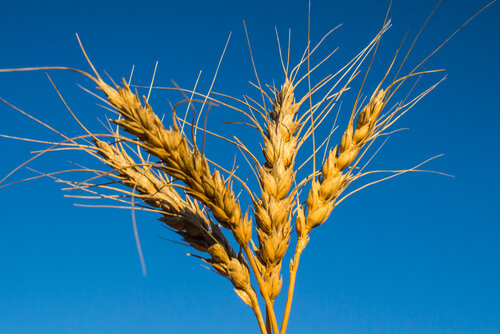Breeding Field-Ready Canada Western Red Spring (CWRS) Wheat Cultivars for the Eastern and the Northern Prairies

“Canada exports wheat all over the world because we produce premium wheat that meets or exceeds quality standards. Farmers know that if they fill their bins with Canada western red spring (CWRS) wheat, it will sell,” says Santosh Kumar, research scientist, Agriculture and Agri-Food Canada, Brandon Research and Development Centre.
Kumar develops CWRS wheat for the Eastern and Northern Prairies. These regions enjoy very good wheat growing conditions, so his breeding program focuses on disease resistance and improving yields. Growers in the Northern Prairies have a shorter growing season so, in addition to optimum disease resistance, they also want early maturing varieties.
“We look for a very high tolerance for Fusarium head blight (FHB) and resistances to leaf, stem, and stripe rusts,” he says. “We also focus on common bunt and orange blossom wheat midge resistance.”
In the Eastern Prairies, wheat midge is very prevalent, so Kumar makes wheat midge resistance a priority in his research and variety development program. The germplasm he develops is shared with other breeding organizations who use them to develop improved midge tolerant lines.
“Within the wheat breeding community, we operate as one big unit,” he says. “Breeding is something that needs to be done collaboratively. Nobody can do all of it, so we all compete, but we help each other as well.”
Kumar’s breeding program is divided into three stages:
-
Pre-breeding, or early germplasm development, is when the emphasis is on incorporating new sources of disease resistance, abiotic tolerance (against stresses like drought, heat, cold), and establishing the desired plant type.
-
Advanced generation selection is when the elite germplasm is tested in various agro-climatic zones for agronomic, disease, and quality performance. This happens five or six years after the pre-breeding stage.
-
Variety testing is when registration trials are done and results are submitted to the Prairie Grain Development Committee (PGDC) to get support for registration of new varieties.
“We start with 500,000 or 600,000 plants in the early generation and bring it down to three or four important lines that can be tested to become varieties at the registration trial level,” he explains.
He says registration trials are also done collaboratively for three years in 12 locations. “The goal is ultimately to give farmers the best—without compromise, regardless of where it came from or whose line it was.”
A number of Kumar’s lines have been released as new varieties in recent years.
AAC Leroy is a premium quality CWRS wheat. It’s midge tolerant and resistant to all the priority-one diseases (FHB; leaf, stem, and stripe rusts; and common bunt). It also yields more than any other currently available variety. “The farmer doesn’t have to worry about anything,” says Kumar. “They can just grow it.”
AAC Magnet is a hard red spring wheat that is not midge-tolerant, but it has very good FHB resistance and very high yield. “If they don’t have midge pressure in their area, a lot of farmers don’t like to sacrifice other traits for midge tolerance,” explains Kumar.
AAC Redstar is an early maturing variety with very good resistance to all the diseases, and it yields really well. “Finding that rare variety that is early and high yielding is a challenge,” Kumar says.
He’s very excited about his newest line, AAC Hodge. He says it’s among the best for yield and it has all the disease resistance.
“Every year, varieties keep improving. They have better yield, a little bit better disease packages, and they meet new quality standards,” says Kumar. “Bringing all of that in one package is the goal of breeding.”
This Wheat Cluster project received funding from Agriculture and Agri-Food Canada through the AgriScience Program, which is part of the Canadian Agricultural Partnership, a federal, provincial, territorial initiative. The project also received funding from Alberta Wheat Commission, Saskatchewan Wheat Development Commission, Manitoba Crop Alliance, and Western Grains Research Foundation.
For the project profile, CLICK HERE.